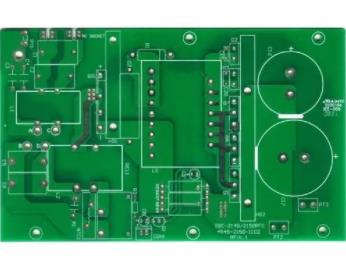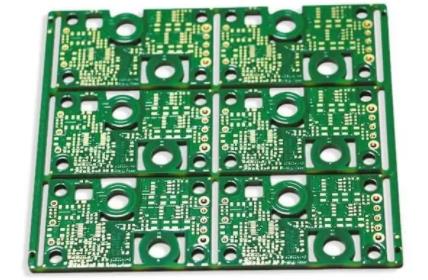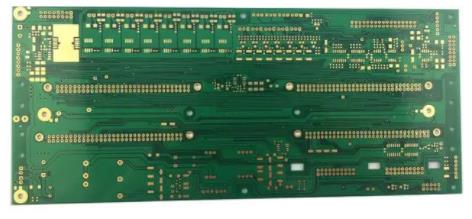

What is the dielectrIC constant and loss factor of RO4350B at 24GHz?
PCB manufacturers, PCB designers and PCBA manufacturers explain to you what the dielectric constant and loss factor of RO4350B board are at 24GHz?
The dielectric constant of RO4350B is relatively stable. The standard value is 3.48 at 10GHz, and the dielectric constant will decrease with the increase of frequency. The dielectric constant at 24GHz decreases by 0.01 to 3.47 compared with 10GHz.
High frequency PCB boards are generally selected from the following aspects: low dielectric constant, low loss factor, frequency and temperature stability, and cost (material cost, design test manufacturing cost). RO4350B produced by ROGERS is a low loss material of hydrocarbon resin and ceramic filler laminate and prepreg, which has excellent high-frequency performance (generally can be used below 30GHz). Since RO4350B is processed with standard epoxy resin/glass (FR-4) processing technology, it also has low processing cost of the circuit. It can be said that RO4350B has reached the optimization of cost and high-frequency performance, and is the most cost-effective low loss high-frequency plate. In order to better meet the design requirements, the insertion loss of the microstrip transmission line based on RO4350B plate at 24GHz is studied when designing the microstrip array antenna.

Analysis of Microstrip Line Insertion Loss
Microstrip line insertion loss mainly includes conductor loss, dielectric loss, surface wave loss and radiation loss, among which conductor loss and dielectric loss are the main ones. Skin effect makes the high frequency current on the microstrip line concentrate on the thin layer that the conduction band and ground plate directly contact with the dielectric substrate, and the equivalent AC resistance is far greater than the low frequency case. When working below 10GHz, the conductor loss of the microstrip line is much larger than the dielectric loss. When the working frequency rises to 24GHz, the dielectric loss exceeds the conductor loss.
For the insertion loss of microstrip lines of different lengths calculated by HFSS, the dielectric substrate is RO4350B with a thickness of 20mil. It can be seen from the figure that the insertion loss of the microstrip line is about 17dB/m, in which the metal loss, dielectric loss and other losses are 4.47dB/m, 11.27dB/m and 1.26dB/m respectively. As a comparison, Table 1 shows the insertion loss of microstrip lines calculated by MWI2016. It can be seen that the calculated value of MWI under the same conditions is 24.4dB, where the dielectric loss is close, but the conductor loss is 7dB different. The reason for the difference is that the HFSS model does not consider the surface roughness of the guide band and the grounding plate.
Measures to reduce microstrip line insertion loss
1) Reasonable selection of plate thickness and careful use of green oil
It can be seen from Table 1 that the conductor loss of microstrip lines with the same characteristic impedance decreases with the increase of the dielectric thickness, while the dielectric loss is basically unchanged. The reason is that the thicker the dielectric substrate is, the narrower the microstrip line width is, the more concentrated the high-frequency current is, and the greater the conductor loss is. It is worth noting that the loss tangent angle of green oil medium at 24GHz is large, which will increase the microstrip line insertion loss. Therefore, when designing a 24 GHz microstrip antenna, it is necessary to conduct resistance welding and windowing on the antenna area.
2) Preferred LoPro copper foil
The surface roughness of copper foil of conduction band and grounding plate is also an important factor affecting the insertion loss of microstrip line. The smoother the copper foil surface, the SMAller the conductor loss. RO4350B provides two copper clad types: electrolytic copper foil (ED) and low roughness inversion treated copper foil (LoPro). The surface roughness of ED copper foil is about 3um, and LoPro copper foil can reach 0.4um, which can effectively reduce conductor loss. The thickness of the dielectric substrate is 0.1mm compared with the microstrip line insertion loss of the two copper foils. At 24GHz, the insertion loss of LoPro copper foil microstrip line is 40% smaller than that of ED copper foil.
3) Reasonable selection of surface treatment process
The surface treatment process is also one of the factors affecting the conductor loss. There are four common surface treatment processes, including silver precipitation, gold precipitation (nickel free gold), nickel gold (nickel 3-5 um, gold 2.54-7.62 um) and tin precipitation. Among the electrical parameters of these metals, nickel is a ferromagnetic material with a magnetic permittivity of 600. According to the skin depth calculation formula, the skin depth of nickel is one order of magnitude smaller than that of other metals, so the surface resistance of nickel is dozens of tiMES greater than that of other metals, resulting in the conductor loss of nickel gold process being far greater than that of other processes. Comparing the insertion loss of bare copper, silver precipitation and nickel gold surface treatment processes, the substrate thickness is 20 mil. The insertion loss of silver deposition process is SIMilar to that of bare copper, but the insertion loss of microstrip line after nickel gold surface treatment is 4 dB/m (10 GHz) larger. It can be predicted that this difference will be greater at 24 GHz.
To sum up, when we use RO4350B dielectric substrate to design a 24GHz microstrip antenna or microstrip circuit, we need to comprehensively consider the dielectric plate thickness, copper clad type and surface treatment process according to performance and cost requirements. The conclusion is also applicable to most plates of Rogers RO4000 and RO3000 series. PCB manufacturers, PCB designers and PCBA manufacturers explain to you what the dielectric constant and loss factor of RO4350B board are at 24GHz?
然后
聯系
電話熱線
13410863085Q Q

微信

- 郵箱











